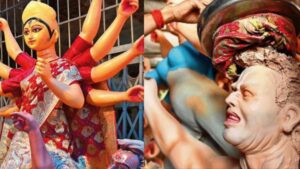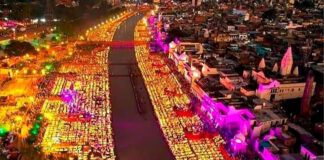OCTOBER 16, 2023

NEW DELHI: With seven days left for Durga Puja, every minute is precious for the murtikars (idol makers) who are flooded with thakurer bayna (booking of idols). While several murtikars from Kumartuli in West Bengal have been summoned to the capital to make the Durga idols, there are others, such as Govind Nath and Manik Pal, who call Chittaranjan Park in south Delhi their home.
Nath, head artisan at Kalibari, a CR park landmark, said, “I have lived in CR Park since childhood. From the time I was a child, I helped my father in the traditional family work of idol making, which my grandfather and great-grandfather too were engaged in.” Nath accordingly turned a childhood interest into a livelihood.
According to Nath, the artisans earn between 10,000 and 50,000 to make each idol of Durga. The final touches are reserved for Mahalaya, an auspicious day around seven days before the pujas, falling this year on Saturday. On the day, Durga’s eyes are painted in a ritual called chokkhudaan (literally ‘gifting of the eyes’).
The idol-making process begins with crafting a sturdy bamboo and straw frame called the kathamo that can support the weight of clay. Straw binds the structure together and forms the foundation for base layers. “Clay from Haryana or Uttar Pradesh is used for the final clay layers. The special clay for the face, imported from Kolkata’s riverbank, adds a quality finishing touch,” revealed Nath. The clay is put layer after layer, being left to dry in the sun each time.
The craftsmanship demands tireless effort, for which the financial rewards are often meagre. Nath acknowledged the challenge, saying, “If you’ve accepted an order, you must deliver the idol on time, even if it means disrupting our daily routine.”
Pal, equally renowned, is working on the figures of Durga, her consort Shiva, children Ganesh, Kartik, Lakshmi and Saraswati, and Mahishasura at the Chandralok Cinema Complex. This cinema hall, once known for screening low-budget and regional cinema, operated between the mid-’70s and the early 2000s, occasionally showing Bengali films on Sundays. Today, Chandralok has become a temporary home to artisans who breathe life into the idols of gods and goddesses that will make their way to the grand pandals in CR Park and other places in the city.
An enchanting aura hangs over the narrow alleys near the cinema hall. The idols, some in half-finished glory, stand tall and arresting. In the chiaroscuro, Pal, who moved from Krishnanagar in West Bengal to Delhi in 1995, balances precariously on an elevated stool and reaches up to the towering Durga idol. His cup of kadak chai lies forgotten. With every stroke of his paintbrush, he casts a warm, yellow-tinted glow upon her countenance. Suddenly, Durga’s face comes to life,
Pal and his team have meticulously crafted 70-80 Durga idols. “I have 17-18 artists working under me. We have been working for three months. This year, there’s a bigger demand from the puja samitis for the traditional Dhaker Shaaj-style Durga idols,” Pal told TOI. Imported materials, including pristine white thermocol, metal wires, sheets and foil are employed to create intricate ornaments known as Dhaker Shaaj.
Pal and the other artisans also make idols for puja organisers in Punjab, Rajasthan, Himachal Pradesh and Jammu & Kashmir. There are orders from the UK and the US as well. Idols for overseas clients are shipped at least a month before the festival.
While buckets of vibrant colours, bamboo stacks and dried clay strewn all around, the idol makers toil tirelessly. Instead of the usual chakra, lotus and sword in Durga’s 10 hands, at the moment, there are shirts and pants of the craftsmen hanging from the arms of the unfinished idols. But this down-to-earth picture still does not diminish the spirituality of the place where art and devotion find expression in every pat of the wet clay, in every brushstroke.
Courtesy: TOI / PTI










































































































